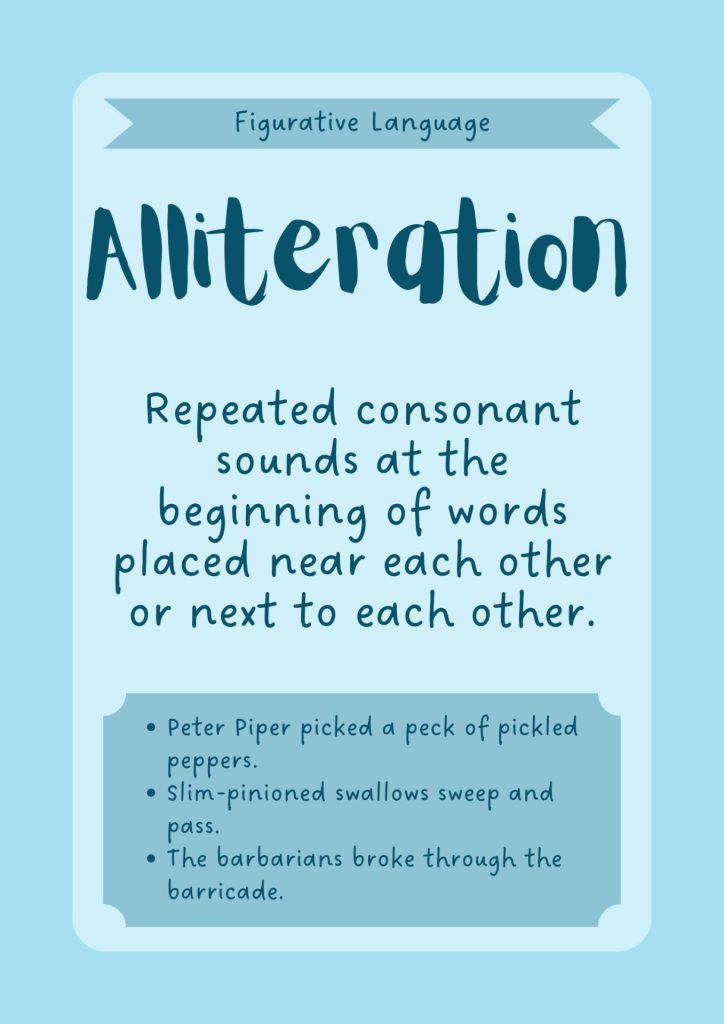What is Alliteration? – Definition and Examples
Table of Contents
Introduction
Alliteration
Alliteration is a figure of speech that plays a significant role in enhancing the musicality and impact of written language. Let’s delve into the world of alliteration and explore its definition, examples, and applications in various forms of writing.
Analogy of Definition
What is Alliteration?
Alliteration is the repetition of the same initial consonant sound in close proximity within a phrase or sentence. This repetition creates a harmonious and rhythmic effect, adding a layer of depth and resonance to the language used.

Method
Identifying Alliteration
Identifying alliteration involves recognizing the repetition of initial consonant sounds in a series of words. It is essential to distinguish alliteration from other literary devices such as consonance and assonance, which involve different types of sound repetition
In literature, alliteration graces the pages of timeless classics, enriching the prose with its melodic charm. In William Shakespeare’s ‘Romeo and Juliet,’ the famous line ‘From forth the fatal loins of these two foes’ showcases alliteration with the repeated ‘f’ sound, creating a sense of foreboding and emphasizing the conflict between the feuding families.
Similarly, in Charles Dickens’ ‘A Tale of Two Cities,’ the phrase ‘It was the best of times, it was the worst of times’ employs alliteration with the repeated ‘w’ sound, emphasizing the contrasting nature of the times described and enhancing the memorable opening of the novel. In Edgar Allan Poe’s haunting poem ‘The Raven,’ the repeated ‘s’ sounds in the line ‘And the silken, sad, uncertain rustling of each purple curtain’ create a sense of softness and melancholy, echoing the whispering of the curtains and enhancing the eerie atmosphere of the poem.
Through the artful use of alliteration, writers paint vivid pictures with words, infusing their writing with depth and resonance. It is a literary tool that invites readers to immerse themselves in the symphony of sounds, appreciating the beauty of language in all its forms.
How to Use Alliteration?
Here are some ways to help you harness the power of alliteration:
- Identify Key Words: Choose words or phrases that you want to emphasize or highlight in your writing. These could be significant nouns, descriptive adjectives, or impactful verbs that capture the essence of your message.
- Experiment with Sounds: Play around with the initial consonant sounds of the selected words to create alliterative patterns. Consider how different sounds evoke different moods or tones—soft, soothing sounds for gentle imagery, sharp, crisp sounds for dynamic action, etc.
- Maintain Clarity and Meaning: While alliteration adds a poetic flourish to your writing, ensure that it doesn’t overshadow the clarity or meaning of your message. Avoid sacrificing coherence for the sake of alliteration; instead, use it as a tool to enhance and complement your ideas.
- Be Subtle and Strategic: Alliteration is most effective when used sparingly and strategically. Incorporate it into your writing where it naturally fits, rather than forcing it into every sentence. Subtlety can often have a more powerful impact than overt repetition.
- Vary Your Patterns: Experiment with different types of alliteration, such as consonance (repetition of consonant sounds) and assonance (repetition of vowel sounds), to create diverse and engaging textures in your writing. Varying your patterns keeps the reader’s attention and adds depth to your prose.
- Read Aloud and Revise: After incorporating alliteration into your writing, read your work aloud to gauge its rhythm and flow. Listen for any instances where the alliteration feels forced or disrupts the natural cadence of the text, and revise accordingly.
By following these guidelines, you can wield the power of alliteration to captivate your readers, elevate your writing, and leave a lasting impression with your prose.
Examples
Example 1: The wild winds whisked through the willow trees.
Example 2: Silly Sally swiftly skipped to the store.
Example 3: Gaby’s green gown gleamed in the sunlight.
These examples illustrate the use of alliteration in creating a rhythmic and melodic effect in writing. The repetition of initial consonant sounds in each phrase adds a musical quality, making the language more memorable and impactful.
Quiz
Tips and Tricks
1. Selective Sound Repetition
Tip: Choose initial consonant sounds that complement the mood or theme of the writing. Avoid overusing alliteration to maintain its effectiveness
2. Rhythmic Flow
Tip: Experiment with the placement of alliterative words to create a rhythmic flow within the writing, enhancing its musical quality
3. Emphasizing Emotion
Tip: Use alliteration to emphasize specific emotions or actions, drawing attention to key elements of the narrative.
4. Balancing Act
Tip: Strike a balance between using alliteration to enhance the writing and avoiding excessive repetition that may distract the reader.
5. Poetic Precision
Tip: When incorporating alliteration into poetry, ensure that it contributes to the overall lyrical and melodic quality of the poem.
Real life application
Story: The Enchanting Echoes of Alliteration
In everyday life, alliteration can be found in various contexts, from advertising slogans to children’s books. Let’s explore some real-life scenarios where alliteration captivates and resonates with its audience.
Scenario 1: Marketing Magic
Companies often use alliteration in their advertising slogans to create a memorable and catchy brand image. For example, ‘Coca-Cola’ and ‘Dunkin’ Donuts’ employ alliteration to make their brand names more appealing and easy to remember.
Scenario 2: Literary Delights
Children’s books frequently utilize alliteration to engage young readers and create a playful and melodic reading experience. Titles such as ‘Green Eggs and Ham’ by Dr. Seuss and ‘Peter Pan’ by J.M. Barrie showcase the enchanting echoes of alliteration.
Scenario 3: Poetic Prowess
Poets harness the power of alliteration to infuse their verses with musicality and rhythm, enriching the emotional impact of their poetry. Poems such as ‘The Raven’ by Edgar Allan Poe and ‘The Waste Land’ by T.S. Eliot exemplify the evocative nature of alliteration in poetry.
FAQ's
Like? Share it with your friends

